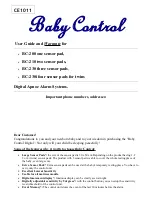
SPM Single Point Monitor
SPM Technical Handbook
A-3
Pin Designations
Signal
Standard SPM
Z-Purge SPM
TGMS
A
1
1
Ground
D
6
6
Tr
E
7
7
Transmit -
F
8
8
R
G
9
9
Receive -
Table A-1: Output Signals
A.1.3 Instrument Port Configuration
The port is configured to be bi-directional and will
result in the instrument periodically “polling” the user’s
equipment. In this mode, the SPM expects the user’s
equipment to be “on-line” and active at all times. That is,
your equipment must accept and respond to each SPM
command. This polling is the user’s opportunity to give
an instruction or command to the SPM.
A.1.4 Communication Port Timeout
The SPM allows the user’s equipment to issue a response
back to the SPM for each communication that occurs.
After each query, the SPM waits for one second for the
response. This period is known as a time-out period.
If your equipment fails to send an acknowledgement of
some form to the SPM within this time-out period, the
SPM will ignore all further communications sent to it until
the SPM institutes another transmission.
Note
The SPM will perform one re-transmission
of the data.
If the SPM is configured to insure communications at
regular intervals, and if it has been more than three
seconds since the last packet was sent, than the SPM
will send a “No Operation” (NOP) packet.
A.1.5 Protocol Specifics
Data and Packets
A byte is a piece of data. It is a way to indicate
information. It is composed of 8 bits of information. A
bit is the smallest possible piece of information. There
can only be two possible values for a bit: 1 or 0 (true
or false). A byte can have a numeric value of anything
between 0 and 255. The number may be interpreted in
a manner other than a number, for example as a letter.
Bytes are often represented as hexadecimal or base
16 numbers. In hexadecimal, the values 10 through
15 are represented by the letters A through F. For
example, 13 is represented by 0D in hexadecimal and
27 is represented by 1B.
Using ASCII characters where HEX 65 (HEX 41) was
the letter “A”, HEX 66 (HEX 42) was the letter “B”, HEX
67 (HEX 43) was a “C” and so on, a message could be
written as these numbers, and each number would be
a byte. For example, to say “BAD” would be 66, 65, 68
(HEX 42, 41, 44).
The collection of the above three bytes (which made
our message) may be referred to as a packet, as these
bytes are always associated with each other.
Just as all words are not the same length (number of
letters), packets may vary in length. One way to denote
the size of the words is to put the number of letters you
have in your word as the first number in your packet.
Your data packet containing the word (or command)
“BAD” will be 3, 66, 65, 68.
Summary of Contents for SPM
Page 8: ...SPM Single Point Monitor Midas Technical Handbook 1 1 1 Operation ...
Page 15: ...SPM Single Point Monitor SPM Technical Handbook 2 1 2 Installation ...
Page 20: ...SPM Single Point Monitor Midas Technical Handbook 3 1 3 Maintenance ...
Page 24: ...SPM Single Point Monitor Midas Technical Handbook 4 1 4 Specifications ...
Page 36: ...SPM Single Point Monitor SPM Technical Handbook 5 1 5 Options ...
Page 53: ...SPM Single Point Monitor SPM Technical Handbook A 1 A Bi Directional Communications Protocol ...
Page 61: ...SPM Single Point Monitor SPM Technical Handbook B 1 B Warranty Statement ...









































